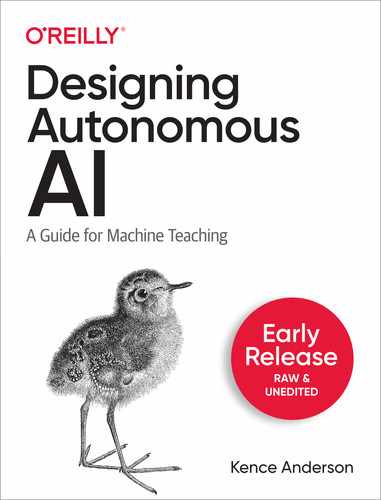Early rules-based artificial intelligence demonstrated intriguing decision-making capabilities but lacked perception and didn't learn. AI today, primed with machine learning perception and deep reinforcement learning capabilities, can perform superhuman decision-making for specific tasks. This book shows you how to combine the practicality of early AI with deep learning capabilities and industrial control technologies to make robust decisions in the real world. Using concrete examples, minimal theory, and a proven architectural framework, author Kence Anderson demonstrates how to teach autonomous AI explicit skills and strategies. You'll learn when and how to use and combine various AI architecture design patterns, as well as how to design advanced AI without needing to manipulate neural networks or machine learning algorithms. Students, process operators, data scientists, machine learning algorithm experts, and engineers who own and manage industrial processes can use the methodology in this book to design autonomous AI. This book examines:
Table of Contents
- Preface
- Introduction: The Right Brain in the Right Place
- What is Autonomous AI?
- Looking for answers to a changing world
- Problems need solutions, not AI
- What can AI do for me in real life?
- Looking for answers to a changing workforce
- Expertise is hard to aquire
- Expertise is hard to maintain
- Expertise is easy to teach, but requires practice
- Looking for answers to pressing problems
- AI is a tool; use it for good
- I. Why do you need an AI brain?
- 1. Sometimes Machines Make Bad Decisions
- Math, Menus, and Manuals: How Machines Make Automated Decisions
- Control theory uses math to calculate decisions
- Optimization algorithms use menus of options to evaluate decisions
- Solutions are like points on a map
- Solving the Game of Checkers: There Is No Spoon
- Expert Systems use stored expertise, like manuals
- 2. The Superpowers of Autonomous AI
- Augmenting Human Intelligence
- How humans make decisions and acquire skills
- Humans act on what they perceive
- Humans build complex correlations into their intuition with practice
- Humans abstract to strategy for complex tasks
- There’s a new kind of AI in town
- Autonomous AI makes more human-like decisions
- Autonomous AI perceives, then acts
- Autonomous AI learns and adapts when things change
- Autonomous AI can spot patterns
- Autonomous AI infers from experience
- Autonomous AI infers from experience
- Autonomous AI can plan for the long-term future
- When should you use Autonomous AI?
- When the superpowers matter most
- When humans need to take over the decision making process
- II. What is an AI brain design?
- 3. Designing AI Brains
- Autonomous AI is like a brilliant, curious toddler that needs to be taught
- Learning multiple skills simultaneously is hard for humans and AI
- Teaching Skills and Strategies explicitly
- People and Process Concerns
- We’re entering an era of teaching intelligence (skills and strategies)
- The Mindset of a Brain Designer
- Teacher more than programmer
- Learner more than expert
- What is a brain design?
- How decision-making works
- Acquiring skill is like exploring an unknown area
- A brain design is a mental map that guides exploration with landmarks
- 4. Building Blocks for AI Brains
- Case Study: Learning to walk is hard to evolve, easier to teach
- So, why do we walk?
- Strategy vs. Evolution
- Teaching walking as three skills
- Brains are built from skills
- What is a concept?
- Concepts are Fuzzy
- Perception concepts discern or recognize
- Action concepts decide and act
- Selector concepts supervise and assign
- Brains are organized by functions and strategies
- Sequences or parallel execution for functional skills
- Hierarchies for strategies
- Visual Language of Brain Design
